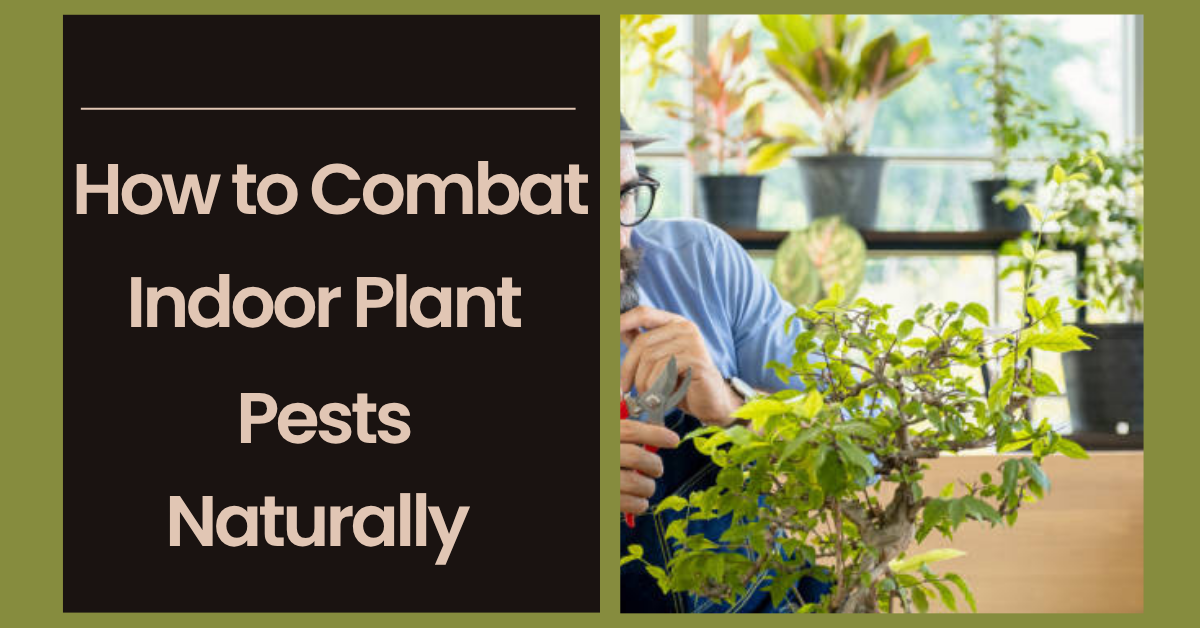Introduction
Indoor plants are a great way to bring nature into your home, but they’re not immune to pests. Aphids, spider mites, mealybugs—these are just a few of the common culprits that can harm your plants. The good news? You don’t have to rely on harsh chemicals to deal with them. There are plenty of natural, effective solutions to get rid of pests while keeping your plants and environment safe.
In this article, we’ll explore how you can combat indoor plant pests naturally, without using toxic pesticides, and help your plants thrive.
1. Neem Oil: A Powerful Natural Insecticide
Why It Works:
Neem oil is an all-natural, non-toxic insecticide derived from the neem tree. It’s a powerful solution that works by disrupting pests’ reproductive and feeding systems. It’s safe for both your plants and the environment, making it a popular choice for eco-conscious gardeners.
How to Use It:
To use neem oil, mix 1 to 2 tablespoons of neem oil with a quart of water and add a few drops of dish soap to help the solution stick. Spray this mixture generously on the plant, especially on the undersides of leaves where pests tend to hide. Repeat every 7-10 days until the pests are under control.
2. Soap and Water Solution: Simple Yet Effective
Why It Works:
A simple mixture of dish soap and water is an excellent way to control soft-bodied pests such as aphids, mealybugs, and spider mites. The soap suffocates the pests by breaking down their protective exoskeletons.
How to Use It:
Mix 1 teaspoon of mild dish soap with 1 quart of water. Using a spray bottle, apply the solution directly onto the affected areas of your plants. Focus on the undersides of leaves, where pests are most likely to congregate. Leave the solution on for about 10 minutes before rinsing it off to prevent soap buildup.
3. Diatomaceous Earth: A Natural Physical Barrier
Why It Works:
Diatomaceous Earth (DE) is a fine, powdery substance made from the fossilized remains of microscopic aquatic organisms. It works by physically damaging the exoskeletons of pests, causing them to dehydrate and eventually die. DE is effective against ants, slugs, and beetles.
How to Use It:
Sprinkle a light dusting of food-grade diatomaceous earth around the base of your plants and on the soil surface. Be careful not to apply it directly to the leaves, as it can irritate delicate plant tissues. Reapply after watering or when the powder becomes wet.
4. Companion Planting: Use Plants to Deter Pests
Why It Works:
Certain plants have natural pest-repelling properties. For example, basil repels aphids, while lavender keeps mosquitoes away. By strategically planting these companions near your indoor plants, you can deter pests and maintain a pest-free environment.
How to Use It:
Add pest-repellent plants such as basil, marigolds, mint, and lavender to your indoor garden. Not only will they look great, but they’ll also help keep common pests at bay. Their scents naturally repel unwanted insects and create a harmonious, pest-free space.
5. Essential Oils: A Natural Bug Repellent
Why It Works:
Essential oils such as peppermint, lavender, and citronella are well-known for their insect-repelling properties. These oils can be used to deter a wide range of indoor pests, from ants to mosquitoes and spider mites.
How to Use It:
Add 10-15 drops of your preferred essential oil to a quart of water in a spray bottle. You can also mix in a few drops of mild dish soap to help the oil adhere to the plant surfaces. Spray this solution directly on your plants and around the edges of your pots. Repeat every few days or as needed.
6. Sticky Traps: Targeting Flying Insects
Why It Works:
Flying pests such as whiteflies, fungus gnats, and aphids can be caught using sticky traps. These traps work by luring flying insects to a sticky surface, effectively preventing them from spreading and damaging your plants.
How to Use It:
Place yellow or blue sticky traps around your indoor plants. The color attracts flying pests, and the adhesive surface traps them. Replace the traps when they are full, or after a few weeks of use.
7. Manual Removal: A Hands-On Approach
Why It Works:
Sometimes, the best method is simply to remove the pests by hand. Larger pests like caterpillars, beetles, or scale insects can often be plucked from plants manually, which prevents further damage.
How to Use It:
Inspect your plants regularly, especially the undersides of leaves. If you spot pests, carefully remove them using your fingers, a soft brush, or a cotton swab dipped in rubbing alcohol. This method is effective for small infestations and allows you to catch issues early before they spread.
8. Rubbing Alcohol: A Quick and Effective Treatment
Why It Works:
Rubbing alcohol is a quick and effective way to eliminate pests such as aphids, mealybugs, and spider mites. It works by dissolving the outer layer of pests, causing them to dry out and die.
How to Use It:
Mix one part rubbing alcohol with two parts water in a spray bottle. Lightly mist the affected areas, focusing on the pest-prone areas like the undersides of leaves. Test the solution on a small part of the plant first to ensure it doesn’t cause any damage.
9. Regular Plant Maintenance: Prevention Is Key
Why It Works:
Preventing pest problems is easier than dealing with an infestation. By keeping your plants healthy and routinely inspecting them, you can catch pest issues early and prevent them from becoming a bigger problem.
How to Do It:
Check your plants for pests weekly. Remove any dead or damaged leaves, clean dust off the leaves using a damp cloth, and ensure that your plants are not overwatered, as stagnant water can attract pests like fungus gnats. Proper maintenance ensures a healthier, pest-free indoor garden.
Conclusion
Combatting indoor plant pests doesn’t have to mean resorting to harsh chemicals. By using natural solutions like neem oil, diatomaceous earth, essential oils, and companion planting, you can keep your plants healthy and pest-free without harming the environment. Regular maintenance and early intervention are key to preventing pest problems, so make it a habit to check your plants regularly.



